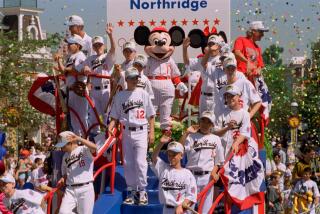Think making your kid play ball year round will help him make the majors? You’re wrong.
ARLINGTON, Texas — A catcher on a little league baseball team that went all the way to the 2018 Little League World Series required bone replacement surgery in his elbow due to overuse.
The boy was 12, but he had caught every inning of every game in a schedule that would likely have exceeded that of some professionals.
For fear of alienating his coach, the parents asked that their son’s name remain anonymous.
As insane as this example is, it is not surprising, for this is our norm.
There is scant evidence to suggest that our current culture of youth sports is good for the kid, and yet the kid keeps doing it against all of the advice from physicians, and those who actually reach the professional ranks.
Virtually all of them — all of them — attest that playing one sport year round is not good, and that we are burning out kids through all-star, select and whatever other leagues we “sell” to parents.
“The road is so long,” said professional baseball player Matt Davidson, “and it really doesn’t matter how good you are at 12. It doesn’t. It only matters if you’re good at 18, and at 21.”
Davidson could have attended USC on a baseball scholarship, but he skipped that after he was a first-round pick of the Arizona Diamondbacks in 2009.
He has played a little more than three big league seasons, and he’s currently in the Texas Rangers’ system. He might be considered an expert.
“The entire system sets kids up to fail,” TCU baseball coach Jim Schlossnagle said. “It sets them up to not like baseball.”
The only people who truly benefit from our current youth sports system are the adults. Everyone admits they are over-doing it, and no one does a thing to stop it.
I wanted to know what those who made the highest level think of all of this, and how our system compares to other nations who contribute big league ball players.
There is no perfect way, but take it from the experts themselves, the pros: If you think you are over-doing it, you are.
“Some kids are playing too much, yes,” said the manager of the Texas Rangers, Chris Woodward.
He might be an authority on the subject.
“I’m reading this book called ‘Range,’ and it’s about this subject. It says the general, non-specialized kid is better. People are too specialized now,” he said. “I am seeing it from the professional standpoint. Kids are not as adaptable because they don’t play other sports. They are training to do one move. Ask them to do something different, and they are not able to because they have been trained since they were 8 to do it one way.
“You see the kids who are athletic who play different sports, they are more open to change. And kids are getting burned out too young.”
If parents know this, then why are we doing it?
“Because,” Woodward said, “they think that’s the only way their kids are going to make the big leagues.”
Here is the lesson: They’re not going to make it. Operate from that standpoint and you’re good.
———
Parents now spend anywhere between $3,000 to $5,000 a year, at least, to cover the costs of a kid in a “select” league. That does not include the price of trips to tournaments in far away locales. Price tags can be as much as $10,000 for a year of youth baseball.
“Then you have to have the right uniform. The same bag as everyone else. There are all of these other costs,” Schlossnagle said. “Then if you don’t play in the fall league, the coach says you are not guaranteed a spot in the spring. That’s unfair to the kid, and their parents.”
Then there are “showcase” tournaments that are designed as exposure to college coaches, and major league scouts.
“A lot of these showcase tournaments that are run by recruiting services we can’t go to because of NCAA rules,” Schlossnagle said. “I will have to have a coach watching 14 and 15 year olds, which is idiotic. I mean, it’s not natural to play one sport at 10. A kid can play 30 games for his high school in the spring, and maybe 30 to 40 in the summer. And that’s fine. Let him play basketball or football or something else.
“Or, I don’t know, maybe go on a vacation.”
Ask yourself, why are you doing it?
Peer pressure is a killer not just for children, but parents, too. No one wants to “miss out,” or feel like they are not doing everything for their kid, even if they can’t comprehend the cost versus the benefit, much less the potential dangers of it all.
If you are spending the money in hopes of your child landing a baseball scholarship, know there are 299 NCAA baseball programs. Those programs can offer 11.7 scholarships for a roster of about 25 kids.
College baseball coaches cut and chop to offer partial scholarships. Potentially a family could spend $40,000 on youth baseball and the player nets a $10,000 a year scholarship in “return.” That’s best case.
Per the NCAA, about 5.6% of boys who play high school baseball as seniors will play college ball. That does not include junior colleges.
If you are doing this in hopes of your boy making it to the bigs, know that about 10.5% of NCAA seniors will be drafted by an MLB team.
And about 0.5% of those high school seniors will be drafted by a big league team.
In short, the odds are horrendous and yet the money pours in to the point where youth baseball in America is a multi-billion-dollar-a-year industry.
“It’s so hard now,” Davidson said. “I’ve seen so many people who get burned out. They are doing all of these things, and they don’t even know why. The kids and the parents both.”
Said Schlossnagle, “Today’s youth player has never been more talented, and he’s never been less skilled. They don’t practice, they just play all of these meaningless games.”
———
More than one-fourth of big league players today are from Latin countries, which do not embrace the American model of youth baseball.
Texas Rangers reliever Jose LeClerc, who is from the Dominican Republic, said he was not coached by an adult until he was 13. His instruction level didn’t change until he signed with the Texas Rangers Academy when he was 16.
Before then, he simply gathered with friends at a nearby field to play a few innings a day.
“That was a normal game,” he said. “We just played the game.”
How novel.
Leclerc played baseball often, and it was his only sport, primarily because baseball is the only game in town.
“I never threw a breaking ball,” he said. “Not until I was maybe 13. You just throw hard, and throw a strike. That’s it.”
Leclerc has one son, and when asked how he would guide or advise him if he wants to pursue baseball, he said, “Don’t try to do too much. If you are going to sign, you’re going to sign. If you are going to be good, the scout will know it.”
How novel.
———
As Josh Jung met with the media at a recent press conference, his parents and younger brother looked on with pride. In this case, the American way worked.
Jung was the Big 12 Player of the Year at Texas Tech, and a first round pick of the Texas Rangers in the 2019 MLB draft.
“We traveled a lot and played all over the country. We were on those travel ball teams with kids who are from Houston and Dallas and San Antonio,” said Jung’s father, Jeff. “We looked at it as two fold; we did it for the person and the athlete. For the life experiences he got from all of this.
“I would not want to know how much we spent on this. You have to be able to justify it.”
Therein lies the tricky part for every parent: Justifying the time, and the money, to put your kid into the high-end world of youth sports in America. And then define the expectations for yourself as a parent, and the kid.
“You hope it leads to something like this, but this is the one percent of the one percent,” Jeff Jung said. “Honestly, it’s terrifying.”
Welcome to parenthood, where you can only learn by doing.
And if you think you’re over-doing it, trust your gut.
More to Read
Go beyond the scoreboard
Get the latest on L.A.'s teams in the daily Sports Report newsletter.
You may occasionally receive promotional content from the Los Angeles Times.










